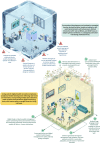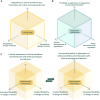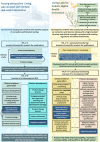A roadmap for safe, regulation-compliant Living Labs for AI and digital health development
- PMID: 40367163
- PMCID: PMC12077496
- DOI: 10.1126/sciadv.adv7719
A roadmap for safe, regulation-compliant Living Labs for AI and digital health development
Abstract
Safe and agile experimentation spaces are essential for developing AI-enabled medical devices and digital health innovations. "Living Labs" offer a collaborative environment for testing technologies in near-real-world settings, capturing user perspectives and outcomes, often missed in traditional testing. However, the flexibility of Living Labs often clashes with the European Union's rigid regulatory frameworks for medical devices that were not designed for digital technologies. We examine this intersection, showing how flexibility in evaluation and patient interaction can coexist with safety guardrails. Our approach integrates technology readiness, preemptive planning, and iterative modifications to bridge innovation and regulation, fostering adaptive health care technology development.
Figures




Similar articles
-
Business Venturing in Regulated Markets-Taxonomy and Archetypes of Digital Health Business Models in the European Union: Mixed Methods Descriptive and Exploratory Study.J Med Internet Res. 2025 Jan 9;27:e65725. doi: 10.2196/65725. J Med Internet Res. 2025. PMID: 39787596 Free PMC article.
-
The Gap Between AI and Bedside: Participatory Workshop on the Barriers to the Integration, Translation, and Adoption of Digital Health Care and AI Startup Technology Into Clinical Practice.J Med Internet Res. 2023 May 2;25:e32962. doi: 10.2196/32962. J Med Internet Res. 2023. PMID: 37129947 Free PMC article.
-
Learning From Experience and Finding the Right Balance in the Governance of Artificial Intelligence and Digital Health Technologies.J Med Internet Res. 2023 Apr 14;25:e43682. doi: 10.2196/43682. J Med Internet Res. 2023. PMID: 37058329 Free PMC article.
-
Digital technologies to unlock safe and sustainable opportunities for medical device and healthcare sectors with a focus on the combined use of digital twin and extended reality applications: A review.Sci Total Environ. 2024 May 20;926:171672. doi: 10.1016/j.scitotenv.2024.171672. Epub 2024 Mar 12. Sci Total Environ. 2024. PMID: 38485014 Review.
-
The role of digital health in pandemic preparedness and response: securing global health?Glob Health Action. 2024 Dec 31;17(1):2419694. doi: 10.1080/16549716.2024.2419694. Epub 2024 Oct 22. Glob Health Action. 2024. PMID: 39435565 Free PMC article. Review.
Cited by
-
Overcoming regulatory barriers to the implementation of AI agents in healthcare.Nat Med. 2025 Jul 18. doi: 10.1038/s41591-025-03841-1. Online ahead of print. Nat Med. 2025. PMID: 40681675 No abstract available.
References
-
- Alowais S. A., Alghamdi S. S., Alsuhebany N., Alqahtani T., Alshaya A. I., Almohareb S. N., Aldairem A., Alrashed M., Bin Saleh K., Badreldin H. A., Al Yami M. S., Al Harbi S., Albekairy A. M., Revolutionizing healthcare: The role of artificial intelligence in clinical practice. BMC Med. Educ. 23, 689 (2023). - PMC - PubMed
-
- N. Gillespie, S. Lockey, C. Curtis, J. Pool, A. Akbari, “Trust in Artificial Intelligence: A global study” (The University of Queensland, KPMG Australia, 2023); https://espace.library.uq.edu.au/view/UQ:00d3c94.
Publication types
MeSH terms
LinkOut - more resources
Full Text Sources

